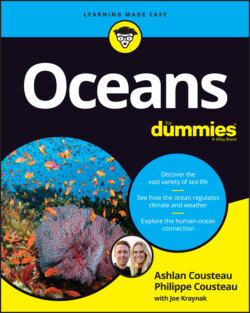Читать книгу Oceans For Dummies - Joseph Kraynak - Страница 85
Dimming the lights in the mesopelagic zone
ОглавлениеJust below the epipelagic zone is the mesopelagic zone (commonly referred to as the twilight zone). This is the region spanning 200 to 1,000 meters (650 to 3,300 feet) below the surface, where some sunlight still penetrates, but not enough for photosynthesis. To feed, most animals in this zone move toward the surface. Others eat whatever detritus (table scraps) and organic matter fall from the epipelagic zone, or they just eat their smaller or weaker twilight zone neighbors.
Source: Cristina Mittermeier – www.sealegacy.org
FIGURE 4-4: Sea turtle.
Source: Keith Ellenbogen – www.keithellenbogen.com
FIGURE 4-5: Tuna.
Some animals in this zone have evolved the ability to produce their own light — a trait referred to as bioluminescence (creating light through biochemical processes). Instead of carrying a flashlight to find their way in the dark, they are the flashlight. Although scientists aren’t quite sure about the purpose of this superpower, they think it might be used to ward off or evade predators (see the nearby sidebar on counter-illumination), detect or lure prey (ooh, shiny light!), or communicate with members of their own species.
Life starts to get a bit weird in this zone. Here, you’re likely to start bumping into cool fish like the lanternfish, hatchetfish, and barbeled dragonfish, all of which can produce their own light. You can also find species of bristlemouths (it’s okay, I brought my own toothbrush). These fish, generally no larger than your finger, are not only thought to be the most common fish in the ocean, but also the most common vertebrate on Earth — more abundant than humans, chickens, and rats combined. Let that sink in for a second. Some marine mammals and sharks can also be found here, but most will stay in the mesopelagic only for relatively short periods before returning to the surface. Swordfish (see Figure 4-6), ctenophores (see Figure 4-7) and siphonophores (jellyfish relatives), and firefly squid are other interesting animals that can be found in this zone.
